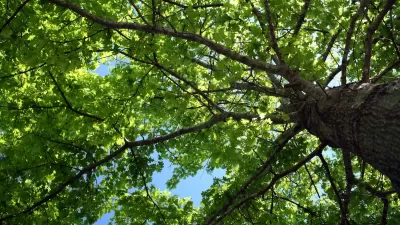Koreatown is one of Los Angeles's densest and most park-poor communities. A privately funded tree planting initiative will bring some much needed greenery and shade to the area.

Shade equity is typically defined as fairness or justice in the way people have access to tree shade in their neighborhood regardless of factors like race, ethnicity, income, etc. As reported by Josie Huang, there is now a privately-funded tree planting initiative to bring some greenery and shade to Koreatown in Los Angeles.
To date, Koreatown Youth + Community Center has raised over $600,000 as part of its plan to speed up the rate of tree planting in the neighborhood, most of the money so far coming from a K-Pop impresario who has made L.A. his second home. The non-profit currently plants about 1,000 trees annually through a $1 million contract with the city, and expects to add another 1,000 trees in the coming year through the privately-funded initiative. The hope is to exceed a $1 million fundraising goal for the first year, so the program can continue for several years.
Koreatown is one of Los Angeles' most park poor and densest communities. According to the 2016 L.A. Countywide Parks Needs Assessment, Koreatown only has 0.1 acres of parkland per 1,000 residents which is significantly lower than the countywide average of 3.3 acres per 1,000 residents. Also, only 39% of Koreatown residents live within walking distance (half-mile) of a park, which is noticeably below the countywide average of 49%.
FULL STORY: In Tree-Starved Koreatown, More Greenery On Its Way

Alabama: Trump Terminates Settlements for Black Communities Harmed By Raw Sewage
Trump deemed the landmark civil rights agreement “illegal DEI and environmental justice policy.”

Planetizen Federal Action Tracker
A weekly monitor of how Trump’s orders and actions are impacting planners and planning in America.

The 120 Year Old Tiny Home Villages That Sheltered San Francisco’s Earthquake Refugees
More than a century ago, San Francisco mobilized to house thousands of residents displaced by the 1906 earthquake. Could their strategy offer a model for the present?

In Both Crashes and Crime, Public Transportation is Far Safer than Driving
Contrary to popular assumptions, public transportation has far lower crash and crime rates than automobile travel. For safer communities, improve and encourage transit travel.

Report: Zoning Reforms Should Complement Nashville’s Ambitious Transit Plan
Without reform, restrictive zoning codes will limit the impact of the city’s planned transit expansion and could exclude some of the residents who depend on transit the most.

Judge Orders Release of Frozen IRA, IIJA Funding
The decision is a victory for environmental groups who charged that freezing funds for critical infrastructure and disaster response programs caused “real and irreparable harm” to communities.
Urban Design for Planners 1: Software Tools
This six-course series explores essential urban design concepts using open source software and equips planners with the tools they need to participate fully in the urban design process.
Planning for Universal Design
Learn the tools for implementing Universal Design in planning regulations.
Clanton & Associates, Inc.
Jessamine County Fiscal Court
Institute for Housing and Urban Development Studies (IHS)
City of Grandview
Harvard GSD Executive Education
Toledo-Lucas County Plan Commissions
Salt Lake City
NYU Wagner Graduate School of Public Service





























